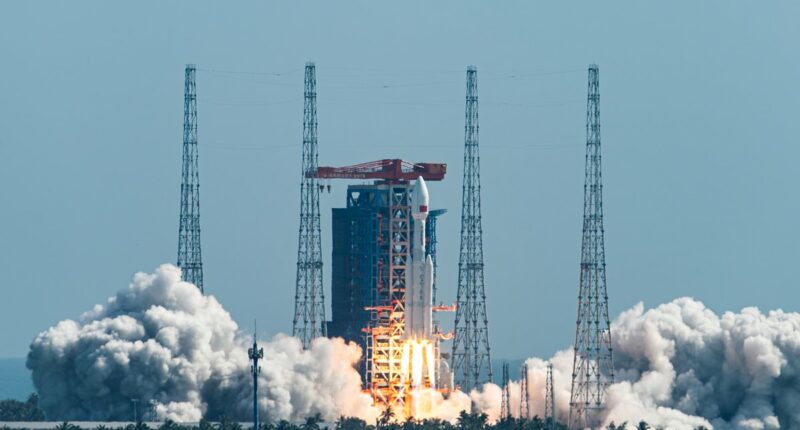Share this @internewscast.com
Chinese scientists are developing ways to destroy Elon Musk’s Starlink satellite network, including laser strikes, custom-built satellites and supply chain sabotage.
They see the system as a growing threat to national security, especially because of its potential to be used by the US in a military confrontation and for spying.
Starlink, which provides low-cost, high-speed internet through thousands of satellites, is now used in more than 140 countries.
Professors from China’s National University of Defence Technology wrote: ‘As the United States integrates Starlink technology into military space assets to gain a strategic advantage over its adversaries, other countries increasingly perceive Starlink as a security threat in nuclear, space, and cyber domains.’
Though Starlink doesn’t operate in China, its satellites still fly over Chinese territory.
That’s enough to trigger alarm among military researchers, who have published dozens of papers on how to track and take down the network.
One study found Starlink could provide constant coverage of key locations like Beijing and Taiwan.
Another highlighted weakness in the system’s supply chain. Some researchers suggested tailing Starlink satellites with Chinese ones, using corrosive substances to damage them or disrupting their solar panels.

Chinese scientists are developing ways to destroy Elon Musk’s Starlink satellite network

China is ramping up its efforts to counter Elon Musk’s Starlink, amid its global reach

Then president-elect Donald Trump listening as Elon Musk describes the operations ahead of the launch of SpaceX’s sixth test flight
Others proposed building optical telescopes to monitor the network or using powerful lasers to destroy Musk’s equipment.
Some experts have also called for diplomatic and legal moves to curb the company’s global reach. One study was bluntly titled: ‘Watch out for that Starlink.’
China is not alone in its concerns – some US allies worry about the risks of relying on a single company, especially one controlled by a businessman whose political views shift regularly.
Musk briefly acted as an adviser in Donald Trump’s administration and has poured money into political causes.
He left the government in May after falling out with Trump on social media.
However, SpaceX continues to win major contracts to launch NASA missions, rescue astronauts, and build surveillance satellites for the US government.
Starlink became a battlefield tool during Russia’s 2022 invasion of Ukraine. The satellites helped Ukraine run drones and maintain communications.
But Musk had final say on how the system was used and refused to extend coverage to support a Ukrainian push into Russian-held Crimea.

Although Elon Musk fell out with Trump and left his government, SpaceX continues to win major contracts to launch NASA missions, rescue astronauts, and build surveillance satellites for the US

Chinese experts see the system as a growing threat to national security, especially because of its potential to be used by the US in a military confrontation and for spying
‘Ukraine was a warning shot for the rest of us,’ said Nitin Pai, co-founder of the Takshashila Institution in India.
‘For the last 20 years, we were quite aware of the fact that giving important government contracts to Chinese companies is risky because Chinese companies operate as appendages of the Chinese Communist Party.
‘Therefore, it’s a risk because the Chinese Communist Party can use technology as a lever against you. Now it’s no different with the Americans.’
Since the war began, Chinese researchers have accelerated efforts to study and counter Starlink.
Starlink currently operates over 8,000 satellites and plans to launch tens of thousands more.
It makes up about two-thirds of all active satellites, according to Jonathan McDowell of the Harvard-Smithsonian Centre for Astrophysics.
Other countries are racing to catch up. Amazon’s Project Kuiper has just 78 satellites in orbit.
Europe is investing heavily in its own system, IRIS2, but is still years behind.

Starlink makes up about two-thirds of all active satellites and currently operates over 8,000 satellites
China’s Guowang network has launched 60 satellites so far, with plans for 13,000. A separate Chinese-backed company, Qianfan, has sent up 90 satellites out of its 15,000 planned expeditions and is targeting markets in Asia, Africa and Latin America.
In the meantime, Starlink’s footprint keeps expanding. It recently gained access to India, Pakistan, Vietnam, Niger and the Democratic Republic of Congo.
Only a few countries, including China, Iran and North Korea, remain out of reach.





